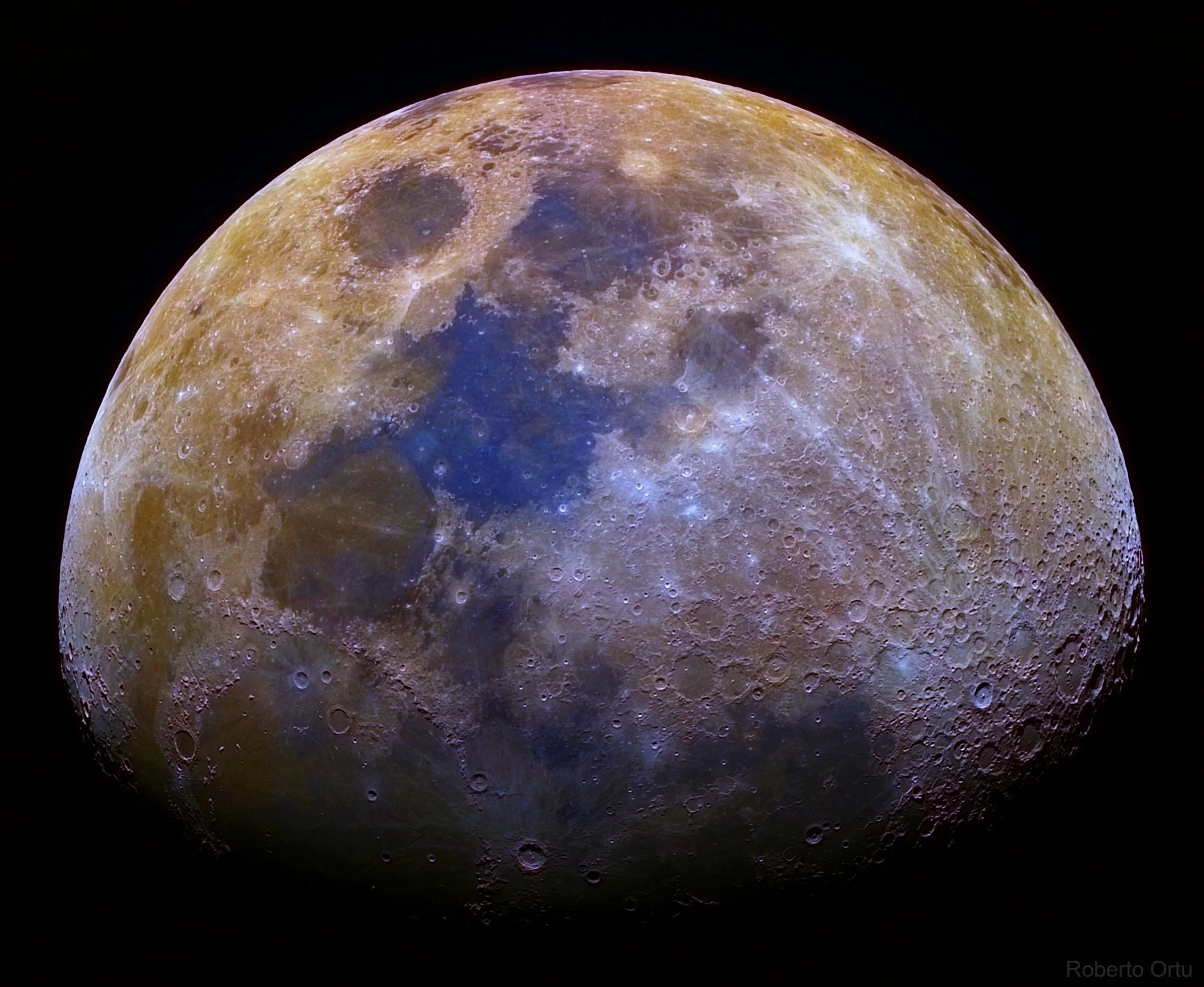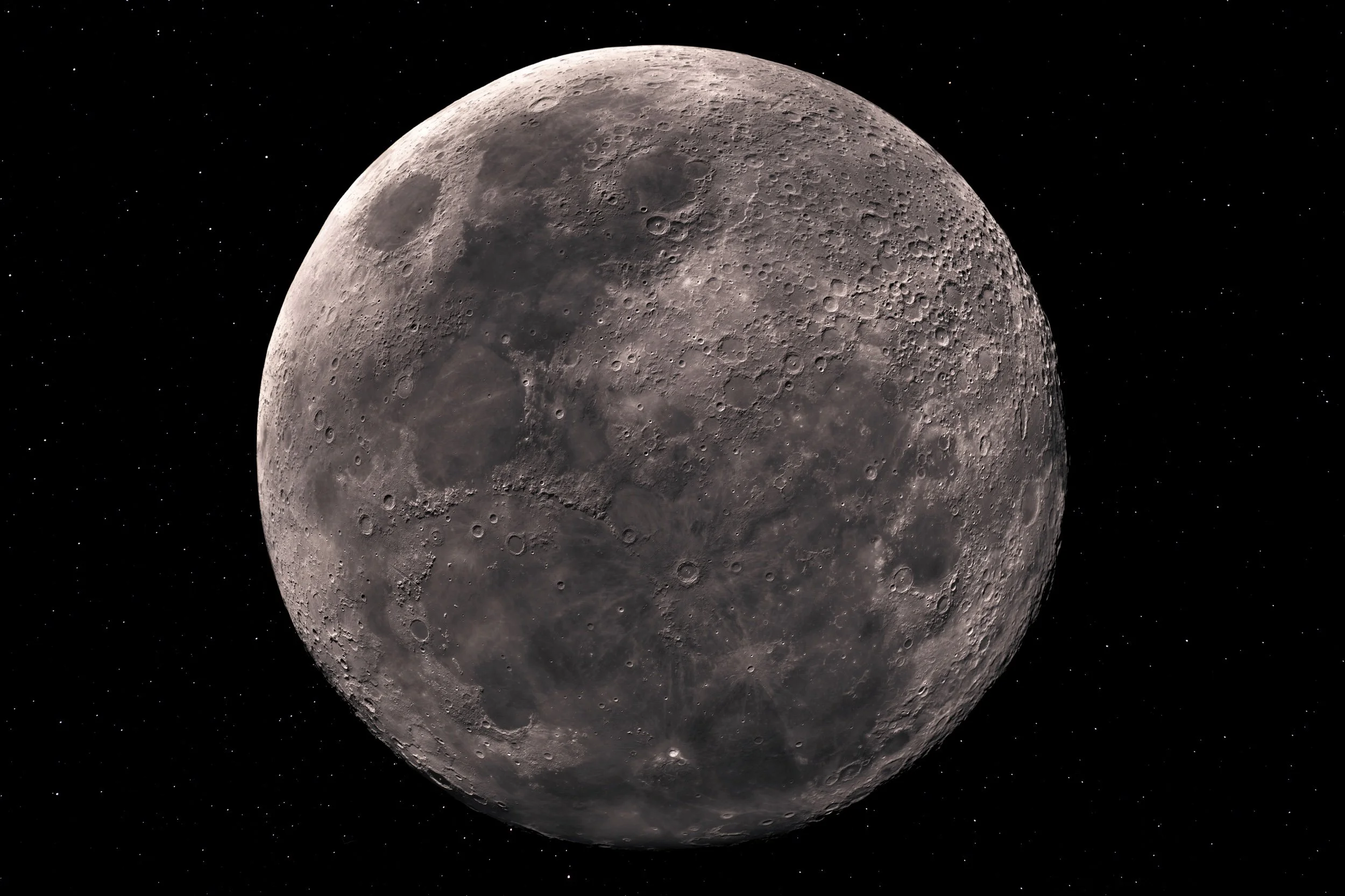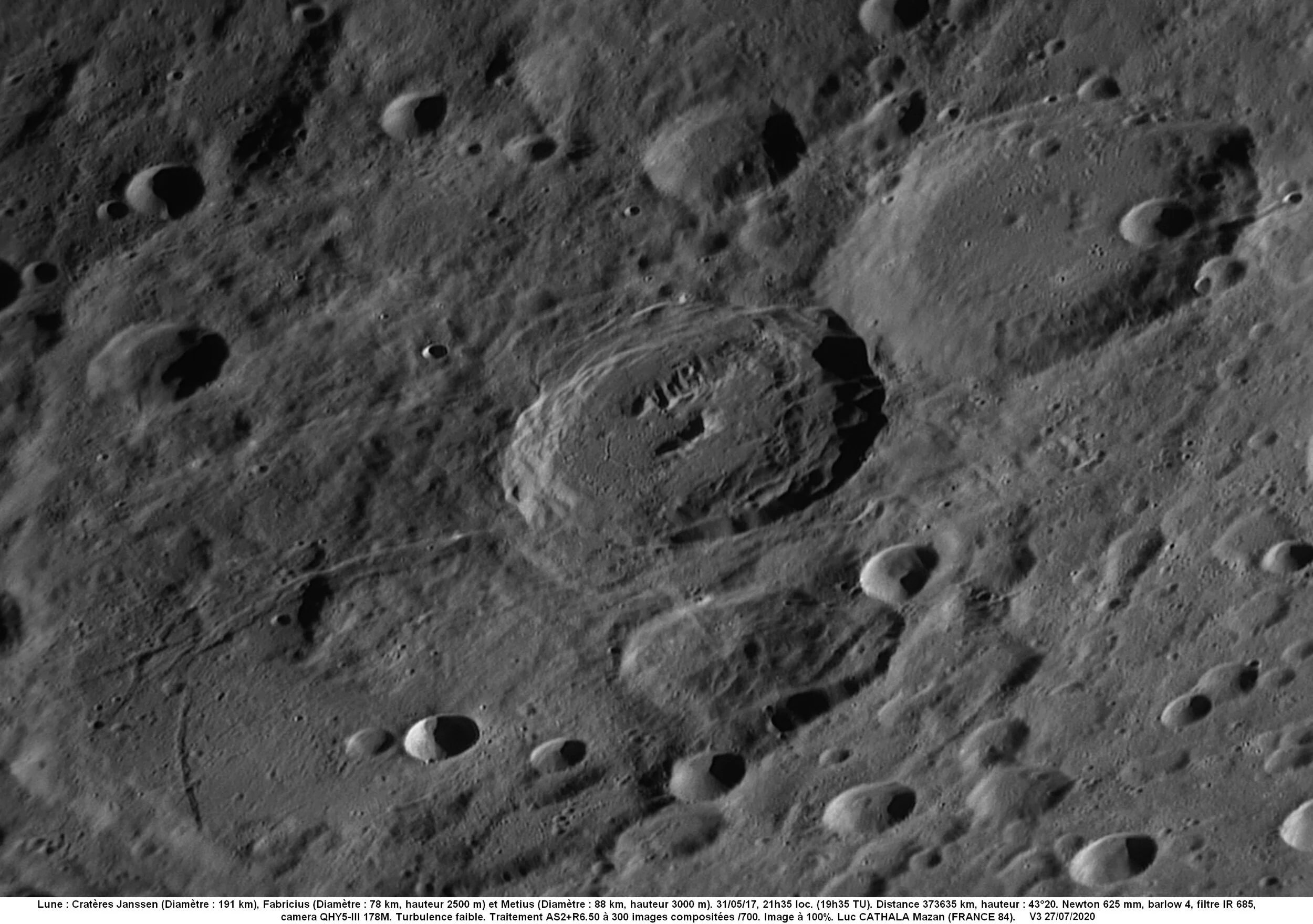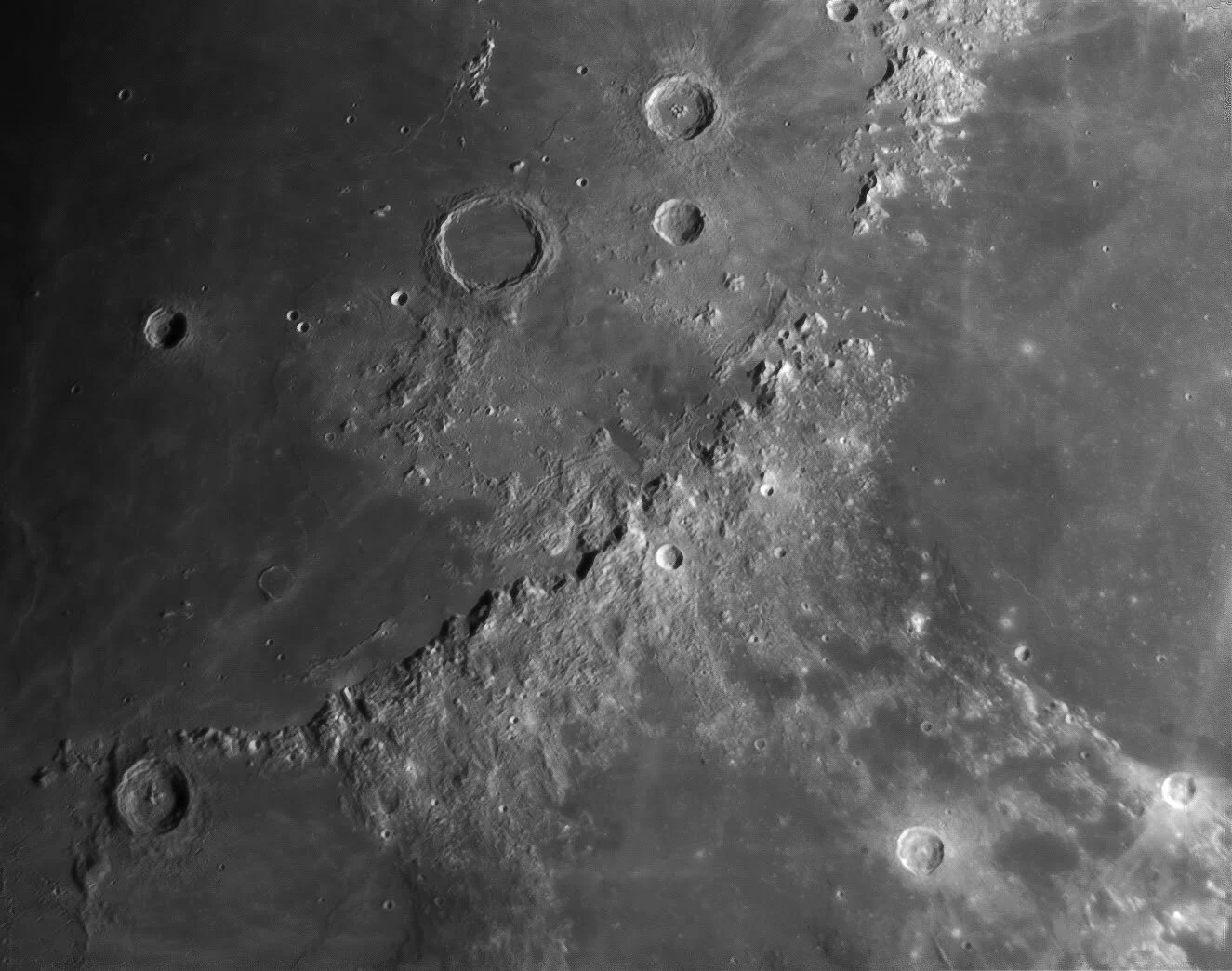
AAPOD2 Image Archives
First Quarter Mineral Moon
This striking image captures the Moon at its first quarter phase, enhanced with a mineral color treatment to reveal subtle variations in surface composition. The blue and brown hues represent differences in the Moon’s geological makeup—blues indicating titanium-rich areas and browns marking regions with lower titanium and higher iron content. Craters and mare basins come to life with added depth and contrast, offering a fresh perspective on our familiar satellite.
Photographed from Shropshire, England, this mineral Moon image showcases how modern processing techniques can turn a classic lunar phase into a visually stunning and scientifically rich portrait.
Saturn and the Moon: A Celestial Encounter
On January 4, 2025, Saturn emerged from behind the Moon in a breathtaking occultation event. Captured at this moment, the southern lunar surface showcases its densely cratered terrain, including striking features such as Clavius and Tycho, whose dramatic shadows accentuate the Moon’s rugged beauty. Saturn, with its iconic ring system tilted gracefully, adds a touch of elegance to this dynamic scene, its golden hue contrasting against the stark, gray lunar surface.
Nearby, the bright star 85 Aquarii adds its light to the composition, a distant companion to this celestial alignment. Such occultations provide a rare and awe-inspiring perspective on the Solar System, illustrating the intricate motions of planetary bodies as viewed from Earth. The juxtaposition of the Moon’s craters, Saturn’s rings, and the distant starlight reminds us of the vast scales and intricate beauty of the universe.
Conquest of the Moon - 55 Years
This photo highlights the regions and dates of the six manned landings on the Moon, with special emphasis on the location of the first manned landing carried out by Apollo 11. The historic landing site of Apollo 11, where Neil Armstrong and Buzz Aldrin first set foot on the lunar surface on July 20, 1969, is marked prominently. This site, known as Tranquility Base, remains a symbol of human achievement and exploration.
In addition to Apollo 11, the photo also marks the locations of the subsequent Apollo missions: Apollo 12 at the Ocean of Storms (November 1969), Apollo 14 at the Fra Mauro highlands (February 1971), Apollo 15 at Hadley Rille (July 1971), Apollo 16 at the Descartes Highlands (April 1972), and Apollo 17 at the Taurus-Littrow valley (December 1972). Each landing site is a testament to the advancements in space technology and the bravery of the astronauts who ventured into the unknown.
The Moon - March 2024
The Moon, Earth's faithful celestial companion, presents an ever-changing visage as it journeys through its phases. Along the terminator—the dividing line between light and shadow—lies a captivating region where the rugged lunar landscape meets the stark contrast of darkness. Here, the interplay of light and shadow reveals intricate details of lunar features, from towering mountains to expansive plains, casting dramatic silhouettes against the lunar surface.
At the terminator, where the Sun's rays graze the lunar landscape at a shallow angle, the terrain becomes a canvas for the interplay of light and shadow, offering us a prime opportunity to explore the Moon's topography in exquisite detail. Craters, mountains, and valleys stand out in stark relief, their features accentuated by the contrasting illumination along the terminator. This region serves as a window into the Moon's geological history, offering insights into the processes that have shaped our celestial neighbor over billions of years. As the Moon waxes and wanes, the terminator shifts, unveiling new vistas and unveiling the mysteries of our lunar companion with each passing phase.
STOP ON THE COSMIC WAY Comet 12P-pons-brooks
Captured in this wide-field frame, this image showcases the celestial ballet featuring Comet Pons-Brooks (12P), the Andromeda Galaxy (M31), the Triangulum Galaxy (M33), the Moon, and Jupiter. Against the backdrop of the night sky, Comet Pons-Brooks graces the scene as it journeys through the solar system, leaving a trail of wonder in its wake. The majestic Andromeda Galaxy, our neighboring spiral galaxy, and the Triangulum Galaxy, another member of our cosmic neighborhood, adorn the heavens with their spiral arms and stellar glow.
Adding to the cosmic spectacle, the Moon and Jupiter make their presence known, further enhancing the beauty of the scene. With its cratered surface illuminated by the Sun, the Moon serves as a familiar anchor in the night sky. Meanwhile, Jupiter, the largest planet in our solar system, shines brightly with its distinct bands of clouds and swirling storms. Together, these celestial objects offer a captivating glimpse into the vastness of the universe, reminding us of the interconnectedness of cosmic phenomena and the wonders that await exploration beyond our own world.
Lunar encounter in French Alps
In the early hours of Wednesday, January 31, an extraordinary rendezvous unfolded between the Moon and the majestic Aiguille de Baude. As the first rays of dawn graced the summit of Aiguille de Baude, the Moon, ever the elusive companion, began its silent retreat, casting fleeting shadows across the rugged landscape.
A colorful Moon mosaic
Image Description and Details : This is my lunar mosaic of the waxing gibbous mineral Moon (9.50 days old).
Technical data:
Celestron 114/910 Newton
Planetary camera QHY5L-II-C
Filter UV IR cut
Software: Sharpcap 3.2, Autostakkert! 3.1.4, Astrosurface T5-TITANIA, Autostitch, GIMP
Location: Cabras, Sardinia, Italy
Copyright: Copyright: Roberto Ortu
Vallis Inguirami
Image Description and Details : Vallis Inghirami
Inghirami (91km) and Vallis Inghirami (145km), can only be well observed in favorable librations of west longitude. In this particular photo, the libration was 6.56º.
The crater and vallis appear to have suffered a landslide. Online reading reveals that this surface was formed by the molten material ejected from the Mare Orientale formation. The molten ejecta exploded in the Inghirami Valley and splashed onto the crater floor and then solidified.
Note that the terraces at Vallis, reminiscent of glacial crevasses, are aligned with gradient and sloping flow, implying that they were formed in a liquid state. Second, the crater ruptured in two places in the northwest, carrying the flow of ejecta that covered the crater floor.
Also Vallis Inguirami is on the famous Lunar 100 list created by my friend Chuck Woods with the number 97.
Almost all telescope users are familiar with French comet hunter Charles Messier's catalog of diffuse objects. Messier's 18th-century listing of 109 galaxies, clusters, and nebulae contains some of the largest, brightest, and most interesting deep-sky treasures visible from the Northern Hemisphere. It's no wonder that observing all M objects is considered a virtual rite of passage for amateur astronomers.
But the night sky offers an object bigger, brighter and more visually captivating than anything on Messier's list: the Moon. However, many backyard astronomers never go beyond the astro-tourism stage to acquire the knowledge and understanding necessary to truly appreciate what they are seeing, and how magnificent and amazing it really is. Perhaps that's because after identifying some of the moon's most visible features, many hobbyists don't know where to look next.
The Lunar 100 list is an attempt to provide Moon lovers with something similar to what deep sky observers enjoy with the Messier catalogue: a selection of telescopic sights to spark interest and improve understanding. It features a selection of the 100 most interesting regions, craters, basins, mountains, channels and domes on the Moon. It is a challenge for observers to find and observe them all and, more importantly, to consider what each feature tells us about lunar and Earth history.
Lunar Anatomy 100
Objects in Lunar 100 are arranged from easiest to view to most difficult. This is more systematic than the random approach that produced the Messier list. In fact, just knowing the Lunar 100 number of a feature gives you an idea of how easy or challenging it will be to see. For example, the Moon itself is L1, while L2 is the cinereous light and L3 is the light/dark dichotomy between the lunar highlands and maria ("seas"). I'd be surprised if anyone reading this couldn't tick those off the list right now. Objects with higher numbers are smaller, less visible, or positioned closer to limbo, making them more difficult to locate and visualize.
I invite you to use Lunar 100 to guide your explorations of the Moon (https://en.wikipedia.org/wiki/Lunar_100).
Source: Refreshing Views Observatory, Marc Radice / Lunar 100, Chuck Woods, Sky & Telescope, GarySeronik / Wikipedia
Adaptation: Avani Soares
Copyright: Astroavani
Is this close enough for you?
Image Description and Details : This ultra high resolution of the full moon was constructed using a total of 1530 individual photos captured during all consecutive phases of the moon from new moon to full. The resulting single image measures a whopping 165,000 megapixels, (50,000 x 33.000 pixels).
The assembly of the final images took over 300 hours to stitch together to piece together this one single image.
Imaged from Perth, Western Australia using ...
Skywatcher 12@ Dobsonian Goto Telescope
2x Barlow lens
ZWOasi 183mc Camera
A video presentation with description of several major craters can be found on the above link.
Copyright:: David Gray
Catena Davy and Muller?
Image Description and Details :
Some time ago I posted a photo with the Astrobin comment ( http://www.astrobin.com/57641/ ) that I suspected that the alignment of craters near Muller could be a Catena.Seeing this new photo taken a few days ago when the two are present (Muller and Davy) this feeling gets even stronger.Still, I reserve the right to doubt mainly due to the diameter of the craters that appear to form Muller, they are too large for us to imagine a stone block of this size rebounding or even a succession of blocks hitting the Moon after the initial object has been fragmented. .However, not being totally impossible, the suggestion for posteriority remains.Catena, catenae (Chain of Craters) -Name adopted by the UAI to designate a chain of craters on the surface of the moon or a planet. They are the result of the rebound and eject material from the impact that formed the main crater. Davy crater crater is one of the most spectacular crater ridges on the Moon, stretching about 50 km away from the rim of ancient Davy crater.
Copyright: Astroavani
The Janssen Fabricius and Metius
The Janssen Fabricius and Metius trio caught with low turbulence and my Newton 625mm IR685 barlow Televue 4X and QHY5III 178M . Note the three connected valleys in Fabricius.
Copyright: Luc Cathala
Montes Apeninos
Image Description and Details The Apennines stretch a total length of about 600 km and the mountain peaks reach heights of 5000 m. The slopes towards Mare Imbrium are relatively steep with slopes of approximately 30 °, while on the opposite side, towards Mare Vaporum and Sinus Aestuum they are significantly less.
Equipo:
Telescopio CPC1100
Cámara Zwo Asi 385mc
Observatorio CASA
Granada / España
Copyright: Benjamin Hernandez
HorseSHoe Crater in mare crisium
Image Title: Horseshoe Crater in Mare Crisium
Image Description and Details : This is not the most spectacular image I have captured of the Moon, but what transpired with it is.
NASA has awarded Firefly Aerospace of Cedar Park, Texas, approximately $93.3 million to deliver a suite of 10 science investigations and technology demonstrations to the Moon in 2023. The delivery, planned for Mare Crisium, a low-lying basin on the Moon’s near side, will investigate a variety of lunar surface conditions and resources. Such investigations will help prepare for human missions to the lunar surface.
My friend Brian Hamilton Day from NASA Ames Research Center presented me with a challenge to try and capture Horseshoe Crater in Mare Crisium, where the Firefly mission landing is mentioned above. Brian then sent this image to the Chief Engineer at Firefly Aerospace and here is a segment of that conversation.
*** I brought Horseshoe Crater forward as a challenge object to the Amateur Astronomy Selenology Project, a group of expert lunar imagers. With its small diameter, low profile and no significant albedo difference from the surrounding terrain, this is truly a very challenging subject of terrestrial imaging. It is only visible when close proximity to the terminator results in greatly prolonged shadowing that accentuates its modest topography. Gary Varney, one of the leaders of the group, responded successfully with the enclosed image. Gary captured this remarkable image at the 96% waning gibbous phase using an 11-inch aperture Celestron CPC Deluxe 1100 Edge HD telescope, an Altair IMX174 Mono camera, and a 3X barlow lens. With this demonstration that this is indeed a possible target, the challenge of tracking down this remarkable landform could add to the public interest and involvement in this very intriguing area, especially if it becomes the target of a landed mission. A current effort by the Solar System Treks development team in conjunction with Cal State University Los Angeles is adding functionality to the Moon Trek portal facilitate ground-based telescopes and amateur astronomers tracking down and identifying a wide range of lunar landforms such as this. ***
Firefly responded...
*** Thanks Bryan, that’s a fantastic image! We are discussing the possibility of operating some hours into the lunar night. This image shows that even after our lander is in the dark, we’ll still be able to see the horseshoe for a period. We’ll have to discuss an exact definition of “dusk” with our Contracting Officer.***
Copyright: [Gary P Varney ][1]
[1]: http://www.facebook.com/gary.varney.79
Sinus Iridum to Plato
Image Description and Details :
Sinus Imbrium to PlatoSinus Iridum (“Bay of Rainbows”) to crater Plato on the northwestern rim of Mare Imbrium. Out in the lava sea, Montes Recti (“Straight Range”) points toward Montes Teneriffe just below Plato (“Tenerife Mountains”, as in the Canary Islands. These isolated mountains form part of an inner impact uplift rim of Imbrium, gouged by an asteroid estimated at 236 km across.Santel MK-91 230 mm f/13 Maksutov-Cassegrain (FL 3,000 mm) on an AP 900 mount, from January 25, 2021. Camera: FLIR Grasshopper 2 GigE; Best 1,600 of 13,200 frames at 22 FPS, from Ossipee, New Hampshire.
Copyright: Robert Gillette
Moon Montes Apeninnus and Eratosthenes crater
Image Description and Details :
Registration on Feb. 20 of a set of interesting formations on the edge of the Mare Imbrium, starting with the Eratothenes crater (diam. 58 km, depth 3600 meters), where the mountain range of the Apeninnus Mountains begins, extending for 953 km formed by the rubble the great impact that created the Mare Imbrium. Apeninnus is home to some of the highest peaks on the visible face of the Moon, including Mons Huygens which according to the most recent and accurate assessments reaches 4950 meters.In the upper part of the image, it is also possible to observe a ghost crater Wallace, remnant of a crater formed in the Imbrian period (3.8 ~ 3.2 a.a.) that was filled by lava and formed edges located 400 meters above the surface.In the box, a perspective view (generated through QuickMap) of Mons Huygens.Tele GSO 305 mm @ f / 12, ASI290MM camera
Copyright: Conrado Serodio
Lunar craters: Endymion & Hayn
Many interesting the crater Hayn located to the northeast limb of the Moon. The observation of the crater is affected by the libration phase and this limits its view.
C14 Edge HD, Fornax52 mount, ASI174 mono, Baader R+IR>610nn Barlow Zeiss.
https://www.astrobin.com/full/ue0hip/0/?nc=user
Agerola-Amalfitan-Coast-Italy
Copyright: Morrone Luigi



















